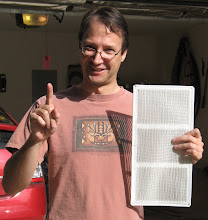 As you can see, the usage for 2009 is well below the 2008 usage, even though 2009 was the hottest year here in central Texas, EVER. The improvements that helped lower the usage this year included completing the radiant barrier (which was only about 40% done in 2008) and installing enough attic insulation to bring the R-value up close to the current code of R-49. In all previous years, the insulation was an estimated R-20.
As you can see, the usage for 2009 is well below the 2008 usage, even though 2009 was the hottest year here in central Texas, EVER. The improvements that helped lower the usage this year included completing the radiant barrier (which was only about 40% done in 2008) and installing enough attic insulation to bring the R-value up close to the current code of R-49. In all previous years, the insulation was an estimated R-20.The numbers:
2005 usage = 13866 kWh
2009 usage = 5731 kWh
Reduction for all improvements (read the Executive Summary to see them all): 58%
For just the 2008-2009 comparison:
2008 usage = 6982 kWh
2009 usage = 5731 kWn
Reduction for 2009 improvements (completed barrier, added insulation): 18%
One thing a lot of people focus on when you talk about home energy efficiency is insulation, but as you can see above, from 2005-2008 I reduced my electricity usage by half without adding an ounce of insulation. There is far more to reducing heat flow than adding insulation. Remember, there are 3 ways that heat flows into (or out of!) your house: convection, conduction, and radiation. Traditional insulation addresses conduction quite well, and possibly convection, but it fails miserably at reducing radiative heat gain. Of course, to handle radiation, you need a radiant barrier. More on all of this shortly; I think that a basic understanding of heat flow is critical to the efficiency enthusiast.


No comments:
Post a Comment